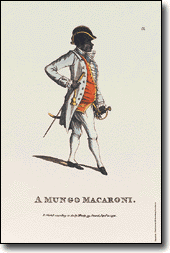Julius Soubise

Julius Soubise (1754 – 25 August 1798) was a freed Afro-Caribbean slave who became a well-known fop in 1760s/1770s Britain. He was one of the most prominent black persons in Britain at the time. [1]
He was born on St. Kitts in the Caribbean, the son of a Jamaican slave[2]. He was bought by Royal Navy Captain Stair Douglas[3] and taken to England at the age of ten.[4] In 1764, he was given to Catherine Douglas (née Hyde), Duchess of Queensbury who was a celebrated eccentric and beauty. The Duchess gave Soubise a privileged life, treating him as if he were her own son - apparently with her husband Charles Douglas, 3rd Duke of Queensberry's blessing.[5]
Trained by Domenico Angelo (whom Soubise also regularly accompanied as usher to Eton and Windsor[5]), Soubise became the riding and fencing master to the Duchess.[1]. He became popular amongst young noblemen and he rose as a figure in upper class social circles, becoming the member of many fashionable clubs[5]. He was known as an amateur violinist[2], singer and actor - he was taught oration by the famous actor David Garrick who befriended a number of black people.[5] The personal favour and patronage of the Duchess allowed him a lifestyle of womanizing and fashion. He would sometimes call himself "The Black Prince" and claim to be African royalty. [6]It was rumoured that Soubise and the Duchess' relationship developed into a sexual one.[7][8]
Soubise became socially prominent enough to be the likely or definite subject of several caricatures - William Austin's well-known satirical engraving, The Duchess of Queensbury and Soubise (published 1 May 1773, showing them engaged in a fencing match) [5][9]; and most notably, A Mungo Macaroni (published 10 September 1772), part of a famous 1771-73 satirical series of engravings depicting fashionable young men published by Matthew and Mary Darly. [10][11] ("macaroni" was a contemporary name for a fashionable young man; "Mungo" was a name of an officious slave from the 1769 comic opera The Padlock by Isaac Bickerstaffe; the Darly engraving was based on a caricature drawn by Henry Angelo). [12]
In the collected letters of the famous freed slave Ignatius Sancho, Letter XIIII dated 11 October 1771 is addressed to Soubise, whom Sancho encourages to consider his lucky position as an unusually privileged black person and so live a more seemly life.[11]
However, on the 15th of July 1777, Soubise fled Britain for India [4] The Duchess died two days after his departure.In India, he founded a riding school in Calcutta, Bengal. Soubise died on August 25 1798 from injuries sustained from falling off a horse.[4][13]
References
- ^ a b Lars Eckstein (2006). Re-Membering the Black Atlantic: On the Poetics and Politics of Literary Memory. Rodopi. pp. p.85. ISBN 9042019581.
- ^ a b ""Black Presence: Asian and Black History in Britain"". The National Archives (UK Government). Retrieved 2007-01-17.
- ^ Felicity Nussbaum (2005). The Global Eighteenth Century. Johns Hopkins University Press. pp. p.233. ISBN 0801882699.
- ^ a b c Vincent Carretta (2004). Unchained Voices: An Anthology of Black Authors in the English-speaking World of the 18th Century (Expanded Edition). University Press of Kentucky. pp. p.103. ISBN 0813190762.
- ^ a b c d e Gretchen Holbrook Gerzina (1995). Black London: Life Before Emancipation. Rutgers University Press. pp. p.54. ISBN 0813522722.
- ^ Vincent Carretta & Philip Gould (2001). Genius in Bondage: literature of the early Black Atlantic. University Press of Kentucky. pp. p.63. ISBN 0813122031.
- ^ Markman Ellis (1996). The Politics of Sensibility (Cambridge Studies in Romanticism). Cambridge University Press. pp. p.84. ISBN 0521552214.
- ^ Laura J. Rosenthal (2006). Infamous Commerce: Prostitution in Eighteenth-Century British Literature And Culture. Cornell University Press. pp. M1 p.161. ISBN 0801444047.
- ^ Henry Angelo (1972;first published 1904). The Reminiscences of Henry Angelo. Ayer Publishing. pp. M1 p.350. ISBN 0405181183.
{{cite book}}: Check date values in:|year=(help) - ^ Miles Ogborn (1998). Spaces of Modernity: London's Geographies 1680-1780. Guilford Press. pp. p.134. ISBN 1572303654.
- ^ a b Ignatius Sancho (Edited by Vincent Carretta) (1998). The Letters of the Late Ignatius Sancho, an African. Penguin Classics. pp. p.257. ISBN 0140436375.
{{cite book}}:|author=has generic name (help) - ^ Henry Charles W. Angelo (1834). Angelo's Pic nic; or, Table Talk. pp. M1 p.61.
- ^ Catherine Lynette Innes (2002). A History of Black and Asian Writing in Britain, 1700-2000. Cambridge University Press. pp. p.27. ISBN 0521643279.
Further reading
- Edwards, P., and Walvin, J., Black Personalities in the Era of the Slave Trade, London, 1983
- Shyllon, F., Black People in Britain 1555-1833, London, New York and Ibadan, 1977
